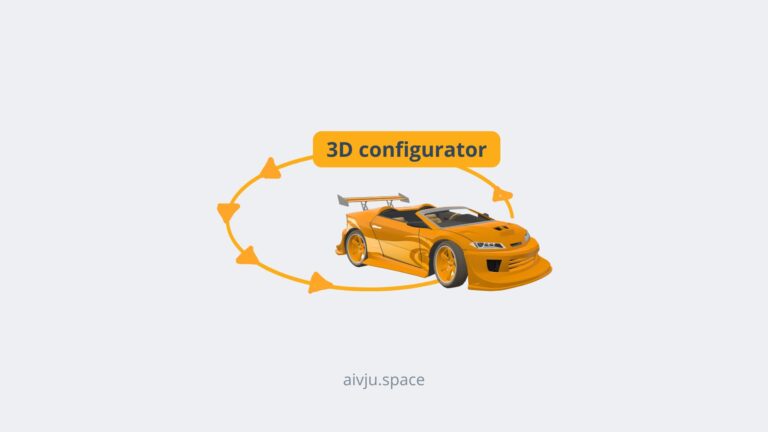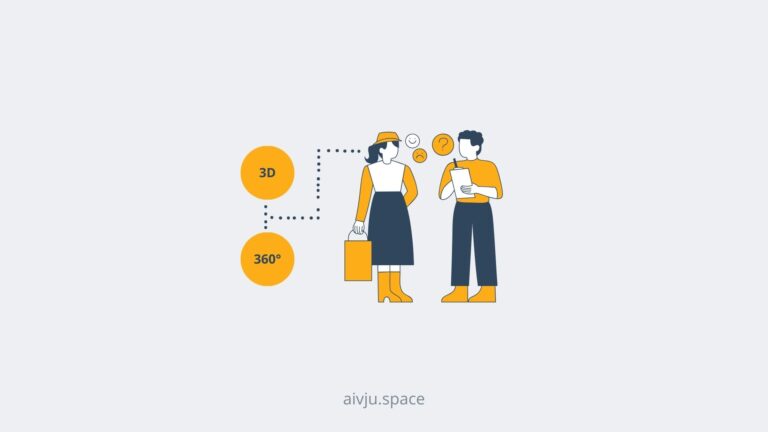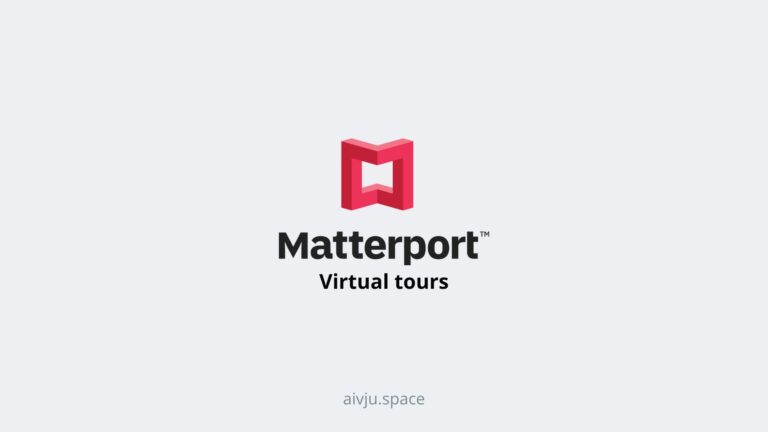You’ve got your 360° photos, 360° videos or virtual tour? … BUT now what? This guide shows you exactly how and where to implement your 360° content (assets) to drive results in your marketing strategy.
Disclaimer: This guide is indented only for the companies which already have their 360° photos (videos) and virtual tour created of their space or object.
In nutshell you can: 1. Embed your virtual tour and 360° photos on your (or business partner) website. 2. Upload it on your Google Business Profile 3. Share it on the social media of your choosing. 4. Use is in your email communication (sales argument) 5. Benefit from it at sales meetings (even business exhibition) 6. Boost your visibility in search results with blog and content marketing
1. Add Virtual tour and 360° content to Your Website (Priority #1)
Why? This is where your most engaged visitors go, and your website is often your first and most controlled impression. A 360° experience here can increase engagement, reduce bounce rates, and guide visitors toward taking action.
But … where we should put our virtual tour on a website?
- Embed the 360° Virtual tour on your homepage or create a dedicated “Virtual Tour” page
- Add it to relevant product/service or location pages.
- Use lightbox popups or sticky buttons with a CTA button “Take a Virtual Tour”.
- Add a floating widget or banner with a call-to-action button
ProTip: For hotels and other big spaces … we recommend using one virtual tour of the whole hotel on home page with all spaces and features and then create separate virtual tours with the same images for each product page (ex. Single bed, Classic Suite, Luxury Suite, …)
ProTip: If you are embedding a virtual tour on your website and storing the data of the virtual tour on your web-hosting. Listen up! Before uploading your virtual tour, check if on your web-hosting storage is big enough to store the data of your virtual tour space and if your hosting is fast enough to load a virtual tour without any problem (aka before 2s maximum).
If not … let your virtual tour provider store the data on external storage or buy yourself a external storage (eg. Amazon S3) and link to the storage with a HTML iframe tag.
When you want to use your virtual tour on the specific webpage for example homepage or “virtual tour” page but not to be automatically in fullscreen mode – use a HTML iframe tag to load content from different storage.
Btw … In most cases your virtual tour provider will help you to embed a virtual tour on your website with iframe tag or specific plugin for CMS websites (content management system) such as WordPress, Wix or Drupal.
Example of HTML iframe tag (generic):
<iframe src=”https://you-website.com/virtual-tour” width=”100%” height=”600px” allowfullscreen></iframe>
Also if you want to use the iframe method … place the virtual tour “above the fold” (the part of the website which is visible without any scrolling).
ProTip: Put a keyword “virtual tour” into a folder name so that it is obvious also for the Google search that this web page includes a virtual tour.
Ex “https://your-website.com/hotel-virtual-tour/simple-room
Also visible keyword into a URL address is also beneficial for sharing in ads, emails and social media posts.
2. Update Your Google Business Profile with 360° photos
Why: Google Business Profile (formerly Google My Business) is one of the first touchpoints potential customers see when searching for your company and adding 360° content boosts visibility on local searches, engagement, and customer trust.
Benefits
- Shows up in Google Search and Google Maps
- Increases click-through rates to your website
- Enhances trust by allowing users to “see before they visit”
- Encourages foot traffic and in-person visits
- Improves your local SEO ranking
Best Practices for Google 360° Content
- Add captions or descriptions to each uploaded image (include keywords).
- Update your 360° content when your space changes (new decor, renovations, etc.).
- Combine with standard photos and videos for a well-rounded profile.
- Encourage reviews that mention the immersive experience!
How to upload your 360° content to my Google Business Profile?
There are two different approaches:
- Upload each 360° photo separate to you profile directly in your Google Business Profile account in photos section
- Use specific software such as Pano2VR, Panopro or other virtual tour software to upload the whole virtual tour to the Google server so that the visitor can go from one place (one 360° photo) to another one. And explore this way the whole space and not just one separate 360° view.
Why: Social media is where attention lives. Sharing 360° photos and virtual tours here helps stop the scroll, boost reach and engagement, and create a memorable experience that static content can’t match.
But the real question is … Which social media platform to use for your marketing efforts with a 360° content? And that is for sure good question … And the answer: “it depend on your target audience” so if your target audience are on Instagram – use it and if they are using different platform adjust your approach and use the platform which bring the highest business results.
And do not worry, you can use 360° content on every platform. Some platform offer you a native 360° support and other do not, but this doesn’t mean that the created content can’t be used on in different format which suits platform’s requirement.
I’ll share with u which formats and platforms works the best currently in the 2025.
Facebook let u post 360° photos in an interactive form (Facebook supports 360° images).
ProTip: The 360° photo will be post as an interactive one only if Facebook recognize that its 360° content. And you can know by seeing an interactive icon before posting a 360° photo on Facebook.
Instagram and TikTok as a video focus platform do not support native 360° support, but short videos are currently very effective (eg. Teaser clips or flat screen-recordings). Also videos of users testing or playing with the virtual tour in the background with some voiceovers seems really engaging and effective.
ProTip: Adding a clear CTA (call-to-action button) to try a virtual tour on your website and putting a link to explore it can be really effective in terms of sales funnel (converting social media visitors to potential buyers on your website).
Plus pinning the video on Instagram on the top of the feed can improve the effectiveness of the post and generate more leads to business.
YouTube on the other hand support 360° video content and you can share a 360° video walk-through of your promises. Need to mention here, that 360° videos are big in terms of data size and good internet connection with higher video resolution in mandatory to deliver seamless user experience.
LinkedIn, X (Twitter), Pinterest and other social media can use the some formats (text, image, screenshot of the virtual tour in use, behind the scenes, …) to showcase spaces as part of brand storytelling or company culture.
ProTip: Combiantion of virtual tour access and WhatsApp can be also interested way how to convert a customer and invite them to your website to make more informed decision.
📬 4. Enhance your Email Campaigns and communication
Why: Email is one of the most direct and cost-effective ways to reach your audience. Integrating 360° content into your campaigns adds visual appeal, interactivity, and a unique experience that traditional emails can’t match.
There are some ideas how you can integrate a virtual tour or a 360° content into yours marketing strategy:
- Improve sales process: Before spending time answering via email the most common question about your offer – provide a link to the full experience on your website where your clients can explore your space with a virtual tour and answer the question for themselves.
- Sales outreach: Provide personalized value and persuade your clients to reach out back with a CTA to explore your new spaces with a virtual tour in a cold-outreach (no strings attached approach – explore our spaces online and if you like it let us know)
- Footer section: Add a link “Discover our space now” or banner image leading to the virtual tour on your website.
- Part of the newsletter or blog content marketing
ProTip: Think about how you can improve your automatic emails when you are out of the office or your shop is currently closed.
No one likes to receive email like “unfortunately we can help u currently” so you can modify it and provide an potential alternative like “hi, you probably have a question regarding our space or our products, right? We are currently closed, but maybe our interactive virtual tour can answer some of your questions. You can check it out “HERE”. If you need a real person interaction – I do my best to answer you tomorrow.”
Feature in welcome emails, open house announcements, or product launches.
Benefits of including virtual tour linking strategy in the email communication (email marketing)
- Increase click-through rates with immersive visuals
- Drive traffic to your website or website of your business partners
- Improve lead nurturing by offering a deeper view of your space or product
- Reinforce your brand’s innovation and transparency
PROTIP: For better tracking the effectiveness of the email campaigns you can use UTM attributes to your links to monitor how many recipients click to view your tour. Also recommend to do some A/B testing to figure out which CTA works the best. (eg.“See Inside [Business Name]” vs. “Your Exclusive 360° Access” vs ….).
5. Interactive content in Sales process & Client Presentations
Why: Makes presentations more dynamic and persuasive. And create the “wow, that amazing” reaction which evoke transparency and trust.
Options how to include it in your sales process:
- Embed tours directly into your pitch decks (Google Slides, PowerPoint).
- Use during Zoom/Teams calls via screen sharing or link sharing.
- Add as part of follow-up emails or proposals.
- On physical meeting you can use a VR device or a tablet to showcase the space or products in an interactive way to support your claim and make it easier for the client to understand.
Virtual tours and 360° visuals make your sales pitch tangible. Whether you’re selling real estate, B2B services, or physical products, 360° content helps prospects visually experience what you’re offering, even remotely — making your pitch more convincing, engaging, and memorable.
🎪 6. Promote your business in Events & Exhibitions
Why: Attracts attention and pre-qualifies interest.
Events and trade shows are crowded, competitive, and noisy. To stand out, you need more than brochures and banners — you need to level up your experiential marketing and invest in tools that stop people in their tracks. And 360° content gives you exactly that.
Whether you’re showcasing a venue, product, facility, or process, a virtual tour and 360° content can simulate the in-person experience for attendees who can’t visit the real thing. Your business can use this techniques:
- Display 360° content on your tablet screens, laptop or mobile devices
- In specific cases a VR headsets can be really beneficial.
- QR codes to let your potential clients visit your website with their own mobile devices (put the QR code on brochures, info sheets, roll-up banners, …)
ProTip: Make sure your virtual tour is 100% mobile-friendly and opens without any login required. This recommendation can prevent creating a negative first impression with your potential client or partner.
We highly recommend using branded virtual tour which client uses on exhibition, because the visitor on the exhibition probably already seen numerous companies stan so far and your experience need to stand out and the visitor need to remember the experience connected to your company.
🧠 7. Reinforce Blog & Content Marketing
Why: Adds depth to storytelling and content.
How:
- Use screenshots or interactive embeds in blog posts.
- Write companion posts like “Behind the Scenes” or “Take the Virtual Tour”.
- Pair with testimonials, case studies, or transformation stories.
Your blog and content strategy are where you educate, inform, and attract traffic organically. Embedding 360° content into your blog posts not only increases time-on-page and visual interest, but also boosts your SEO, keeps readers engaged, and gives your content a unique edge over static competitors.
📊 8. Final recommendations: Monitor, Measure, Improve
Why: Understand what works and improve ROI.
Check list:
- Embed a Virtual tour or 360° content to your website
- Upload the 360° content to your Google Business Profile
- Promote your content on social media platform to reach more visitors (free or paid)
- Integrate your Virtual tour into your email communication strategy.
- Learn how to use and benefit from your interactive content in your sales process.
- If make sense create more content to highlight the benefit of having a virtual tour for your visitors (eg. Blog posts, PR article, Behind the scenes, …, reuse the content for other webpages created)
- After uploading to all beneficial platforms to your business, pause and measure the effectiveness (track clicks, engagement time or heatmaps even). Metrics will differ according to the business goals why the virtual tour was created.
- After the A/B testing just adjust the content to suits your business the best.
- Get the most value out of created 360° content and virtual tour.
FINAL TIP: Just re-purpose existing content as much as you can. Use the existing 360° assets for ongoing lead generation on numerous platform to attract more potential customers and build trust.
Need Help with Implementation or 360° content marketing?
Just let me know on LinkedIn and I can help you by providing me experience and expertise.




